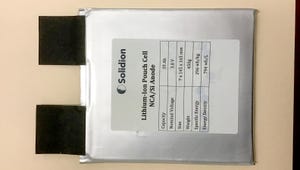Improving Li-ion Battery Production with Materials Analysis
Hitachi’s expert describes how to improve lithium-ion battery yield in a Gigafactory by reducing defects through comprehensive quality control.
July 5, 2023

Johannes Eschenauer, EMEA Business Development Manager – EA8000, Hitachi High-Tech America
Lithium-ion battery manufacturing processes are evolving fast as global demand for EVs continues to increase, and innovative new methods are introduced to optimize vehicle materials and manufacture to minimize energy use.
The drive to achieve more from battery production—yield, cost-efficiency, and sustainability—is at the forefront of the lithium-ion battery production challenges for many. To maintain a competitive advantage and improve yield, it is critical to identify the challenges across the production process that can be improved to increase productivity and minimize waste. This is why materials analysis is central to advancing manufacturing and addressing these challenges.
Reducing battery contamination
Electrolytes, electrodes, separators, and raw materials are all vulnerable to contamination which not only results in consequences to yield but also safety. As metallic contaminants can create safety risks for higher energy density batteries, it is essential to determine the root cause of the defect as early as possible. By successfully monitoring the number, size, and nature of contaminants found in the upstream process, operators can clarify the correlation between those contaminants and the defect ratio.

Stock image of 4680 lithium-ion battery pack manufacturing. Materials analysis can greatly improve yield and efficiency in battery production.
A lack of sufficient testing for all incoming materials, anode or cathode films, carbon black, active cathode material, separators, and base foils can all contribute to the introduction of contamination within the production process. Contamination can also come from abrasive particles introduced during the production process.
We have found that the cost ratio for materials (the relationship between cost of material consumed and sales volumes) in battery cell production is approximately 75%; cell production losses are high, and even up to a 30% scrap rate is not uncommon. Based on a $100 cost per kW/h, we’re talking about a $22.50 loss. Across a 10 GWH Gigafactory production capacity, this equates to a $225 million cost per year.
So, if you improve the defective rate of battery cells by 50%, for example from 1% to 0.5%, how much more profit could you deliver back to the business? If your production volume per year is more than 3GWh, you will be looking at saving millions for your company.
It all starts with raw materials
The extraction of raw materials and the current manufacturing process are not remotely as sustainable as one may wish. However, improved quality control increases yield and reduces waste, for a more sustainable process.
Many raw materials used in lithium-ion battery manufacturing are currently limited in supply in relation to demand leading to rising costs and restricted availability making focusing on reducing waste and maximising yield even more important. To prevent raw materials from being contaminated or containing unwanted trace elements leading to a defective product, 100% incoming inspection is needed, which is easily achievable with today’s material analysers.
Our advice is “trust but verify.” Using trusted suppliers will help, but verification should always be undertaken for certainty and to avoid costs associated with reworking or scrappage.
Monitoring and inspecting metallic contaminants
To effectively monitor materials for metallic contaminants, it is important to know the number, size, and elemental composition of each contaminant, to establish which parameters have the greatest negative effect, and to understand the source of contamination better. However, conventional methods struggle to achieve a comprehensive measurement of all factors. Concentration control instruments are unable to determine the number and size of contaminants, so cannot obtain a correlation between concentration and failure rate. Instruments designed to identify elements and numbers often find it difficult to detect and identify contaminants and may need a longer testing time.

A practical, accurate solution is using an X-ray particle contaminant analyzer. Our unique solution can detect the number, size, and XY position of contaminants in single components, as well as identify the elements in the detected particles by using two powerful X-ray technologies in one instrument: X-ray transmission and X-ray fluorescence. By getting to the root of the defect, production can act on the findings and improve the production yield.
Monitoring and inspecting modern anode materials
For inspecting modern anode materials—which tend to be silicon-based rather than graphite—a scanning electron microscope (SEM) offers a complementary contamination analysis to X-ray analysis. Using an electron beam to excite the sample, SEMs can detect very small particles (from
When fitted with an EDS system, SEMs can detect and determine the composition of metallic and non-metallic particles on any substrate, as well as determine particle size and shape through SEM image and system software.
For more in-depth studies to enhance battery performance as well as yield, it’s important to prepare cross-sections through the raw materials or through the complete cell. This can be challenging with regular mechanical techniques. A high-performance broad ion beam milling system (BIB) with cryo-cooling, wide area milling, and vacuum/inert transfer is an invaluable tool to prepare interpretable cross-sections of LiB materials.
Broad ion beam milling-based cross-sectioning and subsequent high-resolution SEM imaging can be used to study several possible flaws in the formed electrode foil that can be traced back to the different steps in production: mixing/dispersing, calendaring, and coating/drying.
Quality control in the Gigafactory can be implemented through a comprehensive, integrated materials analysis strategy. When introduced across the factory—from the raw materials analysis and R&D stages, through the manufacturing process and recycling of scrap and waste—the individual process benefits accumulate, cumulatively protecting quality and delivering measurable costs, productivity, and sustainability benefits.

You May Also Like



